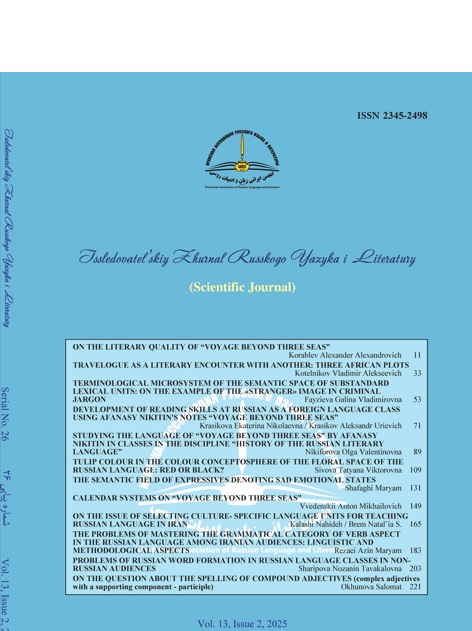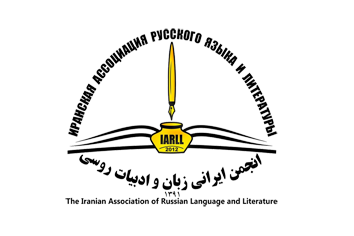ON THE ISSUE OF SELECTING CULTURE- SPECIFIC LANGUAGE UNITS FOR TEACHING RUSSIAN LANGUAGE IN IRAN
DOI:
https://doi.org/10.61186/IARLL.26.9Keywords:
Vocabulary with National-Cultural Elements of Meaning, Culturally Specific Vocabulary, Socio-Cultural Competence, Linguacultural Approach, Teaching Russian as a Foreign Language (TRFL), Associative ExperimentAbstract
Language, being an integral element of culture, emphasizes the most unique in it. In order for Iranian students to fully master socio-cultural competence, it is necessary to acquaint them with the peculiarities of language use within the framework of a new culture. The purpose of this article was to develop and substantiate the procedure for selecting vocabulary with a national-cultural component, which should be introduced to Iranian students in a Russian language lesson at the middle stage of education. The leading research method was an open associative experiment, in which 49 native Persian speakers took part. Iranian associations were compared with associations from the Russian Regional Associative Dictionary, and the number of matching associations was counted for each stimulus. Based on the obtained results, conclusions were made about the need for linguacultural commentary when studying these words at the middle stage of education. Among the culturally specific units we selected, 17% of the stimuli revealed a significant similarity in the associative reactions of Russian and Iranian respondents. They caused 65-80% identical associations, demonstrating the similarity of the national-cultural semantics of these words. Another 7 stimuli (24%) caused 40-65% overlapping reactions, 12 stimuli (41%) caused 20-40% similar reactions, 5 words (17%) activated little or no similar associations in native speakers of Russian and Persian. In our opinion, the comparison of associative fields can be recommended as an effective method for selecting culturally specific vocabulary when teaching Russian according to the first certification level program.
Extended Abstract:
Language, as an integral element of culture, highlights its most unique aspects. For Iranian students to fully acquire sociocultural competence, it is necessary to introduce them to the features of language use within a new cultural context. The aim of this article was to develop and justify a procedure for selecting vocabulary with a national-cultural component that should be introduced to Iranian students in Russian language lessons at the intermediate stage of learning.
The leading research method was an open associative experiment, in which 49 native Persian speakers participated. Iranian associations were compared with associations from the Russian Regional Associative Dictionary (RRAD), and the number of matching associations was calculated for each stimulus. Based on the results, conclusions were drawn about the necessity of providing linguocultural commentary when studying these words at the intermediate level.
Among the selected culturally specific units, 17% of the stimuli showed significant similarity in the associative reactions of Russian and Iranian respondents. They elicited 65-80% identical associations, demonstrating the similarity in the national-cultural semantics of these words. Another 7 stimuli (24%) elicited 40-65% overlapping reactions, 12 stimuli (41%) elicited 20-40% similar reactions, and 5 words (17%) activated few or no similar associations among native Russian and Persian speakers.
The study concludes that comparing associative fields can be recommended as an effective method for selecting culturally specific vocabulary when teaching Russian at the first certification level (B1). The associative experiment proved to be an objective tool for this selection, as it assesses the current state of the language and is independent of the teacher's viewpoint, background knowledge, or personal preferences.
The results of the research are being used to create linguocultural commentaries for Iranian students learning Russian. Work is currently underway, under the guidance of the article's first author, to create a nationally oriented linguocultural dictionary for Iranian students at the B1 level. This approach addresses the challenge of integrating sociocultural competence, which, while a theoretical goal of instruction, often lacks corresponding teaching resources and prepared instructors for its practical implementation.
References
1- Азимов Э. Г., Щукин А. Н. (1999). Словарь методических терминов. — М.: Златоуст.
2- Андрюшина Н. П. (2011). Лексические минимумы по русскому языку как иностранному: проблема отбора лексических и фразелогических единиц // Проблемы истории, филологии, культуры. Т. 3 № 33. С. 648–652.
3- Андрюшина Н. П. (2013). Лексический минимум по русскому языку как иностранному: Первый сертификационный уровень. Общее владение. — М.:Златоуст.
4- Верещагин Е. М., Костомаров В. Г. (1976). Язык и культура. 4-ое изд. — М.:Индрик.
5- Виноградов В.С. (1977). Избранные труды. Лексикология и лексикография. М.: Наука. 312 с.
6- Воркачев С. Г. (2007). Лингвокультурная концептология: становление и перспективы // Известия РАН. Серия литературы и языка. Т. 66. № 2.
7- Воробьёв В.В. (2008). Лингвокультурология. – М.: РУДН. – 336 с.
8- Горошко Е.И. (2001). Интегративная модель свободного ассоциативного эксперимента. Монография. — М. URL: http://www.textology.ru/razdel.aspx?id=38 (дата обращения: 19.04.2024).
9- Калаши Н. (2020). Межкультурная коммуникация и её роль в процессе преподавания РКИ в иранских вузах / Нахидех Калаши // Материалы XX МНПК «Технологии обучения русскому языку как иностранному и диагностика речевого развития». — Минск: БГМУ. С. 262–267.
10- Красных В. В. (2002). Этнопсихолингвистика и лингвокультурология. М.: Гнозис. 284 с.
11- Навильникова Д. И. (2008). Опыт содержательного анализа ассоциативного поля (на примере тематической группы «Еда») // Вестник НГУ. Серия: Лингвистика и межкультурная коммуникация. № 2. С. 116–123.
12- Серкин В. П. (2016). Психосемантика: учебник и практикум для бакалавриата и магистратуры. — М. : Издательство Юрайт. –318 с.
13- Степанов Ю. С. (2001). Константы: Словарь русской культуры. —М.: Академический проект.–590 с.
14- Томахин Г.Д. (1999). США. Лингвострановедческий словарь. —М.: Русский язык. – 576с.
15- Уфимцева Н.В., Черкасова Г.А. (2014). Русский региональный ассоциативный словарь: (Европейская часть России): в 2 Т. —М.: Моск. Междунар. Академия. URL: https://iling-ran.ru/web/ru/publications/evras (дата обращения: 19.04.2024).
16- Фаттахова А.Р., Гилманова Э.Ф. (2022). Культурно-маркированная лексика русского языка с имплементацией в лексикографической деятельности // Арабистика Евразии. Т.5. №2. С.57–74. https://doi.org/10.26907/2619-1261.2022.5.2.57-74
17- Цуй Л. (2022). Совершенствование навыков межкультурной коммуникации китайских студентов вуза посредством освоения зоологического кода русского языка // Филологические науки. Вопросы теории и практики. Т. 15. № 11. С. 3687–3693.
18- Шафии Ф. (2010). Место фразеологии в преподавании РКИ: критерии отбора фразеологических единиц для изучения в иностранной аудитории // IV МНПК «Русский язык как иностранный в современной образовательной и геополитической парадигме». —М.: Макс Пресс. С. 172–174.
Downloads
Published
How to Cite
Issue
Section
License
Copyright (c) 2025 Issledovatel'skiy Zhurnal Russkogo Yazyka I Literatury

This work is licensed under a Creative Commons Attribution 4.0 International License.
![]()
"Creative Commons Attribution 4.0 International (CC-BY 4.0)"


